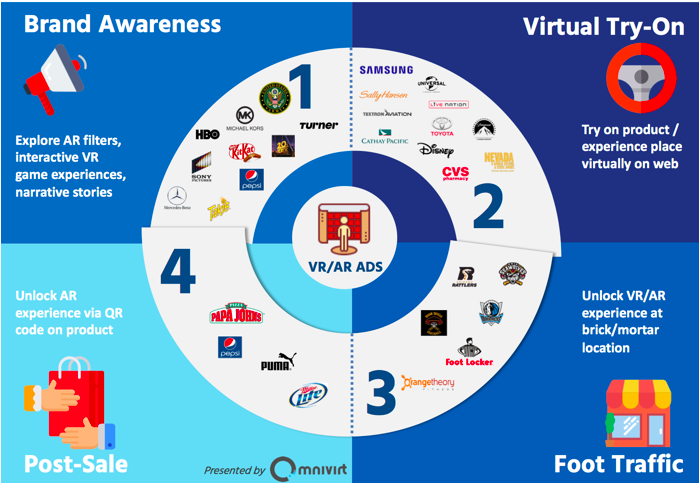
VR/AR Advertising Landscape + Use Cases
As the initial buzz around AR/VR settled down over the past few years, we examined the state of AR/VR advertising today and how companies have used immersive technology in their marketing.
We looked at over 30 campaigns from 2018 and 2019 to understand how brands were using immersive tech to meet their marketing objectives. Through this process, we have identified four key types of VR/AR marketing use cases. We dive into them below:
1. Brand Awareness
Companies have been using VR and AR advertising as a way of increasing brand awareness and solidifying their brand reputation. We’re seeing web-based interactive 360° game experiences, AR filters on social media, and narrative storytelling dominate how brands consider use immersive tech to increase their brand’s reach.
a. Sony Pictures: To promote its movie, “Escape Room”, Sony Pictures created miniature 360 VR escape room puzzles for web users to enjoy. Using rooms inspired by the movie, users solved puzzles to “escape” the virtual room.
b. Michael Kors (AR Filters): Michael Kors became the first company to use Facebook’s new AR filter capabilities with its sunglass overlay AR filter on Facebook. A simple filter allowed users to virtually try on their sunglasses. Here, simplicity was key, and it didn’t go unrecognized. Kors won Mobile Marketer’s Campaign of the Year Award.
c. US Army: Institutions, such as the US Army, have also used it in their recruitment efforts. In one of their most recent campaigns, US Army used VR to combine personal stories with high intensity missions that viewers need to complete, giving them a complete view of what life as a US soldier is like. Using VR advertising, the Army was able to create a personal recruiting campaign by humanizing their soldiers while demonstrating the types of missions that the Army conducts.
2. Virtual Try-On
Whether its flying in the newest model of a private jet or exploring the inner workings of a new hybrid car, there are oftentimes certain sights or experiences that are impractical for every potential consumer to see and have. Companies have addressed this issue through VR and AR technology, allowing consumers to try on the brand’s products in an easy to access way.
a. Textron Aviation: When Textron Aviation released their first super midsize private jet, they had to convince new consumers to trust their product but couldn’t afford to have every potential client physically experience the aircraft in flight. Instead, they turned to VR technology to have people experience the quietness of the flight, see the outside view of a trip to Paris, and test out different interior designs of the plane. Cathay Pacific also did this for their luxury lounges, which led to their highest-performing digital campaign to date.
b. Toyota: Toyota recently used AR technology to allow potential customers to “see” into their Toyota H-CR model (a hybrid vehicle) so that they could understand how the hybrid engine worked and how energy passed through from one part of the engine to another. And by clicking on “hotspot” points, users could get detailed information about specific parts of the car, such as the motor and the battery. Through this innovative use of AR technology, Toyota was able to both educate customers of the benefits of hybrid technology while also marketing their own product at the same time.
3. Foot Traffic
With the rise of e-commerce, physical stores and attractions have had an increasingly difficult time attracting foot traffic. Brands are using increasingly using in-store immersive experiences to delight customers and attract them to brick and mortar postings.
a. Foot Locker: The shoe store chain successful managed to increase foot traffic when they used Snapchat’s AR technology to make in-store posters of LeBron James in Nike gear come to life and dunk in an AR basketball hoop. The brand saw tremendous success, with over two million views in just two days.
b. Arizona Rattlers: Sports teams have also found success with creating unique AR experiences that fans could access inside of stadiums. By putting “hotspots” around the stadium and surrounding areas, the Arizona Rattlers created another compelling reason for fans to attend games. Other teams, such as the Dallas Mavericks, have begun using giant AR advertisements to promote their teams.
4. Post-Sale
Brands have incorporated immersive experiences into their product. These exclusive AR features can only be unlocked through a QR code printed on their products.
a. Miller Lite: For St. Patrick’s Day 2019, Miller Lite created an AR leprechaun that would appear when users scanned the Miller Lite logo on one of their cans. The leprechaun, donned in Miller-Lite branded clothing, would then perform tricks, such as pulling out a Miller-Lite can from its beard.
b. Pepsi: Similarly, Pepsi put a QR code on their bottles that would unlock hundreds of AR Instagram filters and more for their summer 2019 campaign, allowing for greater user interaction with their marketing.
Overall, this examination of the VR/AR advertising landscape demonstrates that companies are beginning to realize the power of this new technology to create unique and engaging advertisements that transcends the typical advertisement status. These case studies show that this technology has been a tried and proven method of achieving and surpassing the level of traditional banner advertisement, and it will continue to do so.
